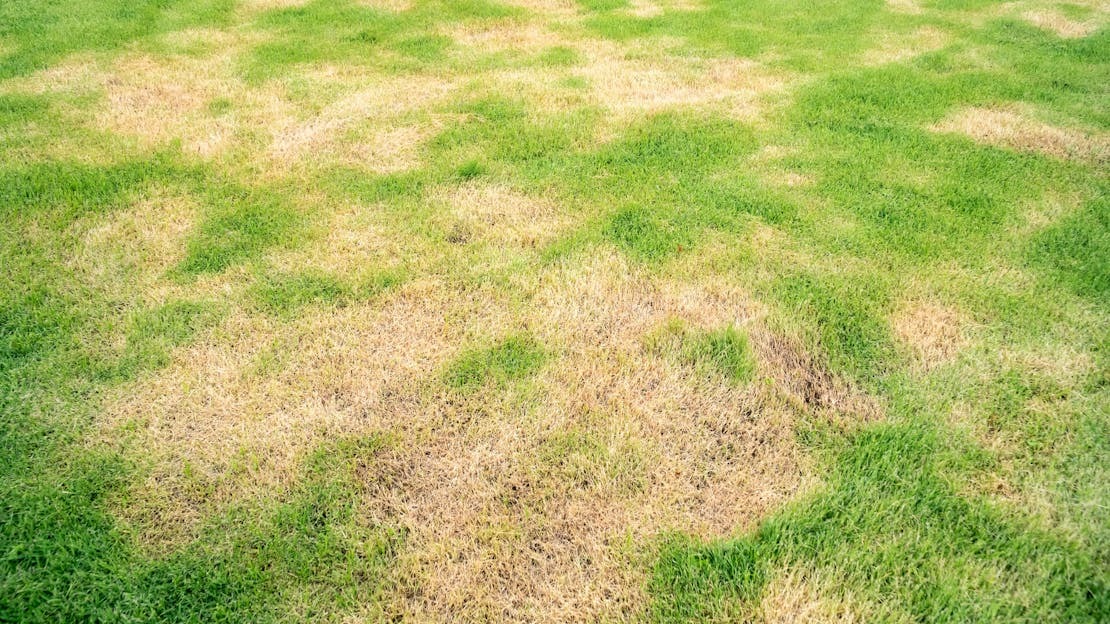
Dry Patch
A patchy network of drying brown grass can be resolved by spiking, hollow tine aeration and wetting agents to bring the lawn back to life
Strictly speaking grass or turf ‘dry patch’ is neither a disease nor a pest but more a ‘condition’ of the soil.
This is a summer or dry weather problem
Dry patch is where the soil has become water repellent and if a sample of soil is taken when the condition is obvious you will find it is snuff dry even after heavy rainfall. The ground will be very hard and when opened up the soil may have a musty smell and contain white specks of fungal growth similar to those in Type 1 fairy rings.
This water repellence causes a patchy network of drying brown grass amongst an otherwise green and healthy lawn. It is often associated with compaction and heavy thatch layers particularly in older lawns or turf on sandy soils. It will often occur near trees, along heavily trafficked areas or slopes. If the problem is particularly severe and occurs frequently during dry weather you should use tried and tested preventative measures. If you don’t manage to prevent occurrences then you’ll need to treat after the event which is harder but does work. Finally if the compaction goes deeper than a few inches you will need to replace the lawn to get rid of it.
Preventative Treatment
Spring Preparation
Ensure thatch is less than ½”. If it is more then it must be reduced. However, if you scarify the lawn you may need to over seed afterwards. This could be a problem on soil that is water repellent so if you do need to scarify I would recommend a deep scarify in the spring before the lawn starts drying out during the warmer drier months.
Next, the affected areas of lawn will definitely need aerating to allow water to penetrate. I would use a hollow tine fork aerator to open the turf up AND relieve compaction. If you have machinery, a lawn aerator or sandals you should spike the lawn afterwards as well. It should be noted that hollow tining in particular will increase drying of the lawn surface so be prepared to water if the weather is dry.
May Onwards
The penultimate step is to apply what is known as a ‘Wetting Agent’ to the lawn. Though this does not cure the water repellent nature of the soil it will enable water to penetrate more easily. You will need to apply wetting agent normally once a month over 3 to 4 months to maintain water penetration. If you can maintain some shallow spiking prior to each application all the better.
Finally, good lawn care practices will continue to make improvements so keep the mowing on the high side to retain moisture, ensure a fertiliser containing potassium is used spring and/or autumn to help the grass plants moisture control mechanisms.
You should also be aware that dry patch will have taken several years to develop in the lawn and is not likely to be cured by this treatment. Therefore, you may well need to re-apply wetting agent plus spiking throughout the late spring and summer of the following year and then periodically as required.
For Existing Conditions
Once the lawn has dried to such a degree, usually after a long dry period it can often take until the following spring to re-wet - not a nice thought!
To speed the process of water penetration and therefore grass revival you should:
- Spike the area densely – you don’t have to go deep and may not be able to due to the hardness of the soil. Just lots of rolling or stabbing of the lawn with a lawn aerator, sandals or garden fork to open channels for water to infiltrate
- Water these areas of lawn for about five minutes a day for a few days. Heavy watering will just run off so a few minutes is all that is required at this stage.
- Add wetting agent
- Water after a week if no rain appears
- Repeat wetting agent and watering once a month until the lawn recovers. This will normally be 2 to 4 treatments. Additional spiking will also help.
If the dryness has left you with dead brown grass then you will need to remove this by raking and then re-seeding the area once you have managed to wet the soil. If this occurs past September wait until spring to seed and start treatment as for a preventative lawn procedure above.